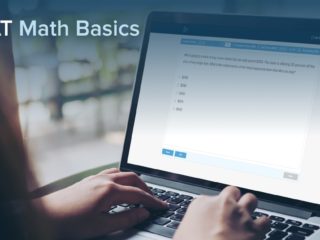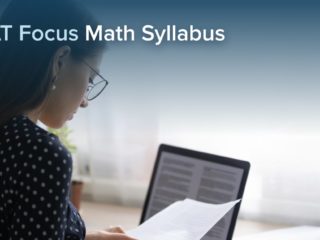| Getting your Trinity Audio player ready... |
If you are currently studying for the GMAT and are in the thick of your prep, you already know the importance of practicing GMAT math problems. To help with your practice, we’re presenting you with a representative selection of GMAT math problems with solutions. Of course, practicing the questions here is just a start. If you need more practice after completing what we offer in this article, please check out the Target Test Prep Online GMAT Course.
Here is what we’ll cover in this article:
- The Topics Tested in GMAT Quant
- Each Major GMAT Quant Topic Can Be Broken Down Into Subtopics
- GMAT Problem-Solving Questions
- Problem-Solving Example 1: Quadratic Equations
- Problem-Solving Example 2: Number Properties
- Problem-Solving Example 3: Exponents
- Problem-Solving Example 4: General Word Problems
- Problem-Solving Example 5: Rates
- Problem-Solving Example 6: Percents
- Problem-Solving Example 7: Combinations and Permutations
- Problem-Solving Example 8: Absolute Value
- Summary
- What’s Next?
Before we jump into examples of GMAT math questions, let’s discuss some key basics of GMAT quant.
The Topics Tested in GMAT Quant
Here is the good news regarding the topics in the GMAT quantitative section. They are similar to those you studied in high school. So, as you jump into your GMAT math prep or even take practice tests, I’m sure many concepts and techniques will come back to you.
However, as you may have already discovered, the math questions you see on the GMAT are not the same types of questions you saw in high school. The GMAT will test your ability to evaluate math analytically. So, you will train new math “muscles” as you learn GMAT quant.
TTP PRO TIP:
Although the topics tested on the GMAT are similar to those you saw in high school, the ways in which the questions are asked may not be familiar.
Here is the list of the quant topics tested on the GMAT.
An Overview of the GMAT Quant Topics
- Basic Arithmetic Problems
- Algebra Problems
- Quadratic Equations
- Number Properties
- Roots
- Exponents
- Inequalities
- Absolute Values
- General Word Problems
- Rates
- Work Problems
- Unit Conversions
- Ratios
- Percents
- Statistics
- Overlapping Sets
- Combinations and Permutations
- Probability
- Coordinate Geometry
- Sequences
- Functions
It’s important to understand that each of these 21 major math topics includes a number of subtopics.
Each Major GMAT Quant Topic Can Be Broken Down Into Subtopics
I often speak with students seeking GMAT math help. In those conversations, I help them analyze their math weaknesses. Most students will look at the macro list and say something like “I struggle with Number Properties.” While such statements are helpful, it’s much more important to understand students’ struggles on a more granular level.
For example, Number Properties includes many subtopics, such as even/odd numbers, positive/negative numbers, divisibility, remainders, the least common multiple, and the greatest common factor, to name a few. It’s possible that a student could excel in some of these subtopics and not in others. So, simply identifying that you struggle with Number Properties, at the end of the day, provides limited information.
Thus, when you’re analyzing your GMAT quant skills, it’s important to look at how you perform on a subtopic, not just a broad area of quant!
TTP PRO TIP:
There are 21 major quant topics on the GMAT, but each main topic includes multiple subtopics.
Let’s now discuss GMAT problem-solving questions in a bit more detail.
GMAT Problem-Solving Questions
The GMAT Quantitative Reasoning section presents you with 21 problem-solving questions, and you have 45 minutes to answer them. GMAT Problem-Solving (PS) questions are a type of question with which you are likely already familiar. This multiple-choice question type presents five answer choices: A, B, C, D, and E, and there is only one correct answer for each question.
Any concept could be tested in a PS question, including all 21 topics we listed previously. To get a feel for how the GMAT presents these questions, let’s do some GMAT PS practice questions. You’ll notice that each sample question is categorized by major topic and subtopic.
Problem-Solving Example 1: Quadratic Equations
Major Topic: Quadratic Equations
Subtopic: The Difference of Squares
What is the value of 998^2 – 2^2?
- 988,036
- 990,000
- 995,988
- 996,000
- 1,000,000
Solution:
If we recognize this question as a difference of squares, we can solve it in less than 30 seconds, doing all the calculations in our heads.
We can recall the fact that, for any numbers a and b, a^2 – b^2 = (a – b)(a + b), we can apply this equation to the expression in the question stem, with a = 998 and b = 2. Thus, we can re-express 998^2 – 2^2 as follows:
998^2 – 2^2 = (998 – 2)(998 + 2) = (996)(1,000) = 996,000
Note that we could have instead solved this question by performing the unwieldy and time-consuming calculation of 998^2, and then subtracting 4. But, instead, by knowing and applying the difference of squares concept, we have avoided the risk of making an arithmetic mistake, and we’ve gained valuable extra time for solving later questions in the quant section.
Answer: D
Problem-Solving Example 2: Number Properties
Major Topic: Number Properties
Subtopic: Units Digit Patterns
What is the units digit of 7^15?
- 1
- 3
- 5
- 7
- 9
Solution:
When we raise the base 7 to successive integer powers, a pattern of the units (ones) digit is revealed. Let’s determine that pattern now by calculating the first few powers of 7.
7^1 = 7 units digit is 7
7^2 = 49 units digit is 9
7^3 = 343 units digit is 3
7^4 = 2,401 units digit is 1
7^5 = 16,807 units digit is 7
So, we see that the units digits of powers of 7 have a repeating pattern of 4 numbers: 7-9-3-1. Thus, every 4th exponent has the same units digit. For example, we see that 7^4, 7^8, 7^12, … etc., will all have the same units digit of 1.
Therefore the most straightforward way of determining the units digit of 7^15 is to find an exponent that is a multiple of 4 close to 15. We know from our pattern that 7^16 must have a units digit of 1. Now, using the pattern 7-9-3-1, we know that 7^15 must have a units digit of 3.
Answer: B
Problem-Solving Example 3: Exponents
Major Topic: Exponents
Subtopic: Solving Exponential Equations by Combining Exponential Expressions With Like Bases
If 16x + 2 * 86 = 326, then x is equal to which of the following?
- 0
- 1/2
- 1
- 3/2
- 2
Solution:
First, notice that we can’t combine any of the expressions in the equation until we re-express the terms with like bases. In this case, the current bases, 16, 8, and 32, can all be expressed as powers of 2. So, we will use the facts that 16 = 2^4, 8 = 2^3, and 32 = 2^5 to rewrite the equation.
16x + 2 * 86 = 326
(24)x + 2 * ( 23)6 = ( 25)6
24x + 8 * 218 = 230
So now that all terms in the equation have the same base, we can combine them, using the fact that when we multiply two terms with like bases, we add the exponents:
24x + 8 + 18 = 230
24x + 26 = 230
We can now use the fact that when we have two exponential expressions with like bases on either side of an equation, we can equate the exponents.
4x + 26 = 30
4x = 4
x = 1
Answer: C
Problem-Solving Example 4: General Word Problems
Major Topic: General Word Problems
Subtopic: Age Problems
Marla is 20 years older than Angelina. In 5 years, Marla will be 3 times as old as Angelina. What will Marla’s age be in 3 years?
- 38
- 33
- 28
- 25
- 23
Solution:
First, let’s define our two variables:
M = Marla’s age today
A = Angelina’s age today
Next, we can write two equations from the information presented in the problem stem.
Since Marla is 20 years older than Angelina, we have:
M = A + 20 (equation 1)
Since in 5 years, Marla will be 3 times as old as Angelina, we have:
M + 5 = 3(A + 5)
M + 5 = 3A + 15
M = 3A + 10 (equation 2)
Next, from equation 1, we can substitute A + 20 for M in equation 2, and then solve for A:
A + 20 = 3A + 10
10 = 2A
5 = A
Finally, we see that Angelina is 5 years old. Thus, Marla is currently 5 + 20 = 25 years old. So, in 3 years, Marla will be 28 years old.
Answer: C
Problem-Solving Example 5: Rates
Major Topic: Rates
Subtopic: Average Rates
Paul walks from home to work at a rate of 5 mph and bikes home from work along the same route at 12 mph. What is his average speed for the round trip?
- 7/2
- 90/17
- 120/17
- 17/2
- 9
Solution:
Since we have an average rate question we can use the following formula:
average rate = total distance / total time
Since the distance is the same in both directions, we can use a smart number to represent the one-way distance. A good number to use would be one that is divisible by both 5 and 12, so we can let the distance each way = 60.
So, the time going to work is 60/5 = 12, and the time going home from work is 60/12 = 5.
Finally we can determine the average rate:
average rate = total distance / total time
average rate = (60 + 60)/(12 + 5)
average rate = 120/17
Answer: C
Problem-Solving Example 6: Percents
Major Topic: Percents
Subtopic: Percent Translations
If p is 500 percent of q, and q is 400 percent of z, then z is what percent of p?
- 2
- 5
- 80
- 100
- 200
Solution:
First, we can note that 500% of a number is equivalent to 5 times that number, and 400% of a number is equivalent to 4 times that number. With these facts in mind, we can create two equations:
p = 5q (equation 1)
q = 4z (equation 2)
We can substitute 4z for q in equation 1:
p = 5(4z)
p = 20z (equation 3)
Now, to find out what percent z is of p, we can divide these two quantities and multiply the result by 100:
z/p ✕ 100
Finally, we can simplify this expression if we use equation 3, plugging in 20z for p:
z/p ✕ 100 = z/20z ✕ 100 = 1/20 ✕ 100 = 100/20 = 5
Thus, z is 5% of p.
Answer: B
Problem-Solving Example 7: Combinations and Permutations
Major Topic: Combinations and Permutations
Subtopic: Choosing Multiple Items in a Combination Problem
A treasure chest contains 5 different rubies, 4 different emeralds, and 3 different diamonds. If a pirate picks 5 jewels from the chest, 3 of which are rubies, how many possible ways exist for him to pick the jewels?
- 21
- 31
- 190
- 210
- 1,584
Solution:
First, he chooses 3 rubies out of 5. Since the order doesn’t matter, we use combinations to count the number of possibilities. Recall the formula for a combination choosing k objects out of n objects is nCk = n! / k!(n-k)!. Thus, the number of ways to choose just the 3 rubies is:
5C3 = 5! / 3!(5-3)! = 5! / 3!(2)! = 5x4x3x2x1 / 3x2x1x2x1 = 20 / 2 = 10
Now, there are 2 remaining choices to make, and there are 7 non-rubies remaining in the chest. Thus, the number of ways to choose the 2 jewels out of 7 is:
7C2 = 7! / 2!(7-2)! = 7! / 2!5! = 7x6x5x4x3x2x1 / 2x1x5x4x3x2x1 = 42 / 2 = 21
There are 10 ways to choose the rubies and 21 ways to choose the remaining jewels.
Therefore, the total number of ways to choose the 5 jewels is 10 ✕ 21 = 210.
Answer: D
Problem-Solving Example 8: Absolute Value
Major Topic: Absolute Value
Subtopic: Evaluating Absolute Value Equations
If |3y – 2| = 1 and y^2 < y, then what is the value of y?
- -1
- -1/3
- 1/3
- 1
- 2
Solution:
First, we can solve this absolute value equation for two cases: when (3y – 2) is positive and when (3y – 2) is negative, as follows:
Case 1: 3y – 2 is positive.
3y – 2 = 1
3y = 3
y = 1
Case 2: 3y – 2 is negative.
-(3y – 2) = 1
-3y + 2 = 1
-3y = -1
y = 1/3
The absolute value equation has two solutions: y = 1 and y = 1/3.
Now, we don’t know which value of y to choose as the answer. We use the given fact that y^2 < y. Let’s test each possible answer, either y = 1 or y = 1/3.
If y = 1, then y^2 = 1. Thus, y cannot be equal to 1.
If y = 1/3, then y^2 = (1/3)^2 = 1/9, and we see that since 1/9 < 1/3 , then y^2 < y.
Thus, the correct answer is 1/3.
We could have skipped these last steps by recalling a fact from Number Properties: The only way that y2 can be less than y is if y is a positive proper fraction — that is, if y is between 0 and 1.
Answer: C
Now that we have practiced many problem-solving questions, let’s shift the conversation to Data Sufficiency questions.
Summary
GMAT quant covers 21 major math topics from the disciplines of arithmetic, algebra, coordinate geometry, number properties, and statistics.
The 21 questions in the Quantitative Reasoning section are all 5-option multiple-choice problem-solving questions. In this article, we have looked at 8 example questions that run the gamut of topics that you might encounter in the GMAT quant section.
What’s Next?
The two keys to success on GMAT quant are knowledge of the 21 topics that are tested and familiarity with what you might encounter. In this article, we have provided you with 8 example questions covering Problem Solving questions.
Another subtopic from Number Properties that challenges many students is divisibility. Read this article to review the divisibility rules and how the GMAT tests them.



